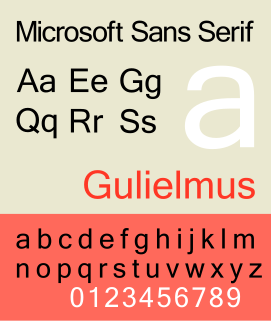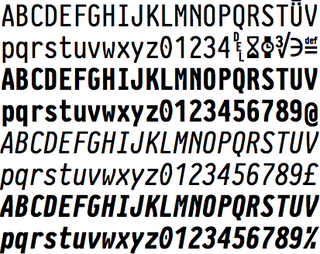Related Research Articles
Bitstream Cyberbit is a commercial serif Unicode font designed by Bitstream Inc. It is freeware for non-commercial uses. It was one of the first widely available fonts to support a large portion of the Unicode repertoire.
Unicode has subscripted and superscripted versions of a number of characters including a full set of Arabic numerals. These characters allow any polynomial, chemical and certain other equations to be represented in plain text without using any form of markup like HTML or TeX.

Monospace is a monospaced Unicode font, developed by George Williams. It is based on the typeface Courier. This font contains 2860 glyphs. It includes characters in the following unicode ranges: Basic Latin, Latin-1 Supplement, Latin Extended-A, Latin Extended-B, IPA Extensions, Spacing Modifier Letters, Combining Diacritical Marks, Greek, Cyrillic, Hebrew, Latin Extended Additional, Greek Extended, General Punctuation, Superscripts and Subscripts, Currency Symbols, Combining Diacritical Marks for Symbols, Letterlike Symbols, Number Forms, Arrows, Mathematical Operators, Miscellaneous Technical, Control Pictures, Enclosed Alphanumerics, Box Drawing, Block Elements, Geometric Shapes, Miscellaneous Symbols, Alphabetic Presentation Forms, Halfwidth and Fullwidth Forms.
Over a thousand characters from the Latin script are encoded in the Unicode Standard, grouped in several basic and extended Latin blocks. The extended ranges contain mainly precomposed letters plus diacritics that are equivalently encoded with combining diacritics, as well as some ligatures and distinct letters, used for example in the orthographies of various African languages and the Vietnamese alphabet. Latin Extended-C contains additions for Uighur and the Claudian letters. Latin Extended-D comprises characters that are mostly of interest to medievalists. Latin Extended-E mostly comprises characters used for German dialectology (Teuthonista).
Unicode supports several phonetic scripts and notations through the existing writing systems and the addition of extra blocks with phonetic characters. These phonetic extras are derived of an existing script, usually Latin, Greek or Cyrillic. In Unicode there is no "IPA script". Apart from IPA, extensions to the IPA and obsolete and nonstandard IPA symbols, these blocks also contain characters from the Uralic Phonetic Alphabet and the Americanist Phonetic Alphabet.
In computing, a Unicode symbol is a Unicode character which is not part of a script used to write a natural language, but is nonetheless available for use as part of a text.

The Unicode Standard encodes almost all standard characters used in mathematics. Unicode Technical Report #25 provides comprehensive information about the character repertoire, their properties, and guidelines for implementation. Mathematical operators and symbols are in multiple Unicode blocks. Some of these blocks are dedicated to, or primarily contain, mathematical characters while others are a mix of mathematical and non-mathematical characters. This article covers all Unicode characters with a derived property of "Math".
Phonetic Extensions is a Unicode block containing phonetic characters used in the Uralic Phonetic Alphabet, Old Irish phonetic notation, the Oxford English dictionary and American dictionaries, and Americanist and Russianist phonetic notations. Its character set is continued in the following Unicode block, Phonetic Extensions Supplement.

Microsoft Sans Serif is a TrueType font introduced with Windows 2000. It is a successor of MS Sans Serif, a proportional raster font introduced in Windows 1.0. Both fonts are very similar in design to Arial and Helvetica. This font was made to match the MS Sans bitmap included in the early releases of Microsoft Windows.
In Unicode and the UCS, a compatibility character is a character that is encoded solely to maintain round-trip convertibility with other, often older, standards. As the Unicode Glossary says:
A character that would not have been encoded except for compatibility and round-trip convertibility with other standards

A subscript or superscript is a character that is set slightly below or above the normal line of type, respectively. It is usually smaller than the rest of the text. Subscripts appear at or below the baseline, while superscripts are above. Subscripts and superscripts are perhaps most often used in formulas, mathematical expressions, and specifications of chemical compounds and isotopes, but have many other uses as well.
In the Unicode standard, a plane is a continuous group of 65,536 (216) code points. There are 17 planes, identified by the numbers 0 to 16, which corresponds with the possible values 00–1016 of the first two positions in six position hexadecimal format (U+hhhhhh). Plane 0 is the Basic Multilingual Plane (BMP), which contains most commonly used characters. The higher planes 1 through 16 are called "supplementary planes". The last code point in Unicode is the last code point in plane 16, U+10FFFF. As of Unicode version 13.0, seven of the planes have assigned code points (characters), and five are named.
The Latin-1 Supplement is the second Unicode block in the Unicode standard. It encodes the upper range of ISO 8859-1: 80 (U+0080) - FF (U+00FF). Controls C1 (0080–009F) are not graphic. This block ranges from U+0080 to U+00FF, contains 128 characters and includes the C1 controls, Latin-1 punctuation and symbols, 30 pairs of majuscule and minuscule accented Latin characters and 2 mathematical operators.
Latin Extended-B is the fourth block (0180-024F) of the Unicode Standard. It has been included since version 1.0, where it was only allocated to the code points U+0180..U+01FF and contained 113 characters. During unification with ISO 10646 for version 1.1, the block was expanded, and another 35 characters were added. In version 3.0 and later, the last 60 available code points in the block were assigned. Its block name in Unicode 1.0 was Extended Latin.
IPA Extensions is a block (0250–02AF) of the Unicode standard that contains full size letters used in the International Phonetic Alphabet (IPA). Both modern and historical characters are included, as well as former and proposed IPA signs and non-IPA phonetic letters. Additional characters employed for phonetics, like the palatalization sign, are encoded in the blocks Phonetic Extensions (1D00–1D7F) and Phonetic Extensions Supplement (1D80–1DBF). Diacritics are found in the Spacing Modifier Letters (02B0–02FF) and Combining Diacritical Marks (0300–036F) blocks. Its block name in Unicode 1.0 was Standard Phonetic.

PragmataPro is a monospaced font family designed for programming, created by Fabrizio Schiavi. It is a narrow programming font designed for legibility. The font implements Unicode characters, including (polytonic) Greek, Cyrillic, Arabic, Hebrew and the APL codepoints. The font specifically implements ligatures for programming, such as multiple-character operators. The characters are hinted by hand.
Latin Extended-E is a Unicode block containing Latin script characters used in German dialectology (Teuthonista), Sakha and Americanist usage.
A number of Greek letters, variants, digits, and other symbols are supported by the Unicode character encoding standard.
References
- ↑ "Unicode character database". The Unicode Standard. Retrieved 2016-07-09.
- ↑ "Enumerated Versions of The Unicode Standard". The Unicode Standard. Retrieved 2016-07-09.